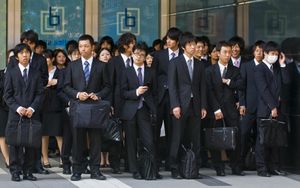Herbivore Men

The term "herbivore men" is borrowed from the Japanese phrase 'soshoku danshi,' and is used to describe Japanese men who do not express their gender in a traditionally masculine way. The term was coined by Maki Fukasawa in 2010, and was soon followed by a string of sub-categories within this newly emerging form of gender expression. The terms used to describe the sub-categories are often food-related; the assortment ranging from ‘cabbage roll men’ to ‘bacon wrapped asparagus men.’ Each type of man has a slightly different way of interacting with women and of presenting themselves physically[1]. The term herbivore men best embodies the general emergence of this new masculinity within Japan, and informs all of the newer specific subsets.
Origin

While the term ‘herbivore men’ emerged in 2010, the actual masculinity it alludes to began to form in the late 1980s. It was at this time that the economic bubble of Japan popped, which instigated shifts to the structure of the long-time career of a ‘salaryman.’ These shifts included reduced job security, and fewer available promotions and raises. As a result, these salarymen began to have to work even harder to make ends meet, and spent less time with their families. Thus emerged an air of anxiety and uncertainty in salaryman; it became an undesirable idea to to work all one’s life to be the breadwinner of a family that may end up resentful towards you.
As a result of these anxieties many younger men began to forgo a long term career path in favour of part-time work[2]. This shift from a focused career path to a part time job gave young Japanese men two things that previous generations didn’t have: spare time and spare money. It was the excess of these two things that allowed for the new expression of masculinity to blossom, and thus emerged the gender expression that now falls under the umbrella of herbivore men.
Attributes
Herbivore men are, in many ways, inverse to the model salaryman. They are unmarried men who do not put a large importance on finding a relationship. They work part-time, as this is enough to support themselves, and also provides them with plenty of spare time. As a result, these herbivore men have have more time to invest into leisure activities and general consumerism.
These herbivore men have an increased awareness and investment in their appearance. They are more aware of what women find attractive in men, as well as what current masculine fashions are trending. With the extra time and money they have, herbivore men are able to invest more into their appearances than the traditional salarymen. This shift in consumerism has also has resulted in less of an emphasis on purchasing big ticket items that salarymen typically prioritized, such as cars and houses.
K-Pop Influence

Much of the current inspiration for the aesthetic of herbivore men currently comes from Korea and their popular K-Pop bands, such as Big Bang. These K-Pop groups are made of up young men, typically aging between 11 and 25, who sing and dance challenging sequences. They are decked out in fashionable wear, and often jewelry, as well as cosmetics to enhance their features.
Many herbivore men have haircuts that emulate the most popular K-Pop stars, and wear similar clothing. They are also inspired by this popular look by investing in simple cosmetics, such as eyeliner and foundation, to enhance their features[3]. The use of cosmetics among the younger generation of men has become more commonplace, and even deemed as attractive by many Japanese women.
Relationships
A large qualifier for herbivore men is also in their outlook on women and relationships. Where salarymen are eager to settle down and are very sexually interested in women, herbivore men are willing to take things slower. They don’t have the same desire to sleep with women, and they prefer to have long term relationships that progress slowly. They are less eager to get married; which is reflected in Japan’s steeply dropping rates of marriage[4].
Soft Masculinity

Many aspects of the masculinity of herbivore men embrace qualities that historically have been more closely tied with femininity. The emphasis herbivore men put on appearance and self-grooming is one such trait that is considered to be more traditionally feminine. It is also important to acknowledge that this performance of masculinity is just that; and expression of gender. In the West a man using cosmetics might be assumed to be a member of LGBT+ community, yet the correlation between sex and gender expression for herbivore men is not so clearcut. In Japan there isn’t the same assumption that these men are interested in same sex partners, which can be largely attributed to the large amount of homophobia present in Japan[5].
This new masculinity, which embraces some more traditionally feminine traits, is not intrinsically tied to sexual orientation. It is what can be referred to as a ‘soft masculinity’, where the more traditional masculinity of the salaryman can can be considered a ‘hard masculinity[6].’ These are useful terms when thinking about new and emerging masculinities.
This soft masculinity has been received with mixed signals within Japan. The older generation within Japan tends to look down upon these herbivore men, who do not place the same importance upon the values of family and careers. These herbivore men are often seen as being lazy and wasteful consumers by this older generation and, largely due to the flexibility of their gender expression and the femininity it embraces, as being weak.

Gender Binary
The gender expression of herbivore men falls within the gender binary, but is more flexible than traditional expressions of masculinity. Herbivore men identify as men, yet do not shy away from their gender expression teetering towards the feminine realm at times. Unlike salarymen, they are not caught up in proving their masculinity to one another; rather they present their new masculinity for both themselves and be more appealing to women.
This is a step forward from the traditional gender binary, in the sense that it allows for a more deep and varied gender expression for men. Of course, drawbacks can come with this advancement. With the added emphasis on appearance for these herbivore men comes the looming threat of ridiculous beauty standards and the potential for judging the worth of these men based upon their looks. This would, of course, be very similar to the treatment that the majority of women face based upon their appearance today[7].
The emergence of herbivore men paves the path for future shifts towards more flexible gender expressions. This soft masculinity has yet to spread to the world at large, but with K-Pop and Japanese fashion slowly gaining more and more popularity, it is plausible to assume that this soft masculinity will spread. If flexible gender expression is becoming more commonplace, then there is hope for non-binary gender expression to also be accepted in the future; perhaps Japan and Korea will be the leaders for this next gender advancement as well.
References
- ↑ Nicolae, Racula. “Sōshoku(kei) danshi: the (Un)gendered Questions on Contemporary Japan.” Romanian Economic Business Review. vol. 9, issue 3. 2014.
- ↑ Nihei, Chikako, and Chikako Nihei. “Resistance and Negotiation: "Herbivorous Men" and Murakami Haruki's Gender and Political Ambiguity.” Asian Studies Review: 37 Vol. Taylor & Francis. 2013.
- ↑ Jung, Sun “Pop Idol Boy Bands and Manufactured Versatile Masculinity: Making Chogukjeok Boys.” Hong Kong University Press, 2011. 2016.
- ↑ Otnes, Cele, Linda Tuncay-Zayer, and Ebooks Corporation. Gender, Culture, and Consumer Behavior. Routledge. New York, 2012.
- ↑ Tamagawa, Masami. "Same-Sex Marriage in Japan." Journal of GLBT Family Studies. Volume 12, no. 2. 2016.
- ↑ Louie, Kam and Low, Morris. Asian Masculinities: The Meaning and Practice of Manhood in China and Japan. Routledge Curzon. New York; London. 2003; 2005.
- ↑ Nussbaum, Martha C. “Objectification." Philosophy & Public Affairs 24.4. Wiley Press. 1995. 249-91.